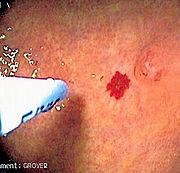
Argon plasma coagulation
Encyclopedia

Endoscopy
Endoscopy means looking inside and typically refers to looking inside the body for medical reasons using an endoscope , an instrument used to examine the interior of a hollow organ or cavity of the body. Unlike most other medical imaging devices, endoscopes are inserted directly into the organ...
procedure used primarily to control bleeding from certain lesions in the gastrointestinal tract
Gastrointestinal tract
The human gastrointestinal tract refers to the stomach and intestine, and sometimes to all the structures from the mouth to the anus. ....
, and also sometimes to debulk tumours in the case of patients for whom surgery is not recommended. It is administered during esophagogastroduodenoscopy
Esophagogastroduodenoscopy
For other expansions of the initialism "OGD", see the disambiguation page.In medicine , esophagogastroduodenoscopy is a diagnostic endoscopic procedure that visualizes the upper part of the gastrointestinal tract up to the duodenum...
or colonoscopy
Colonoscopy
Colonoscopy is the endoscopic examination of the large bowel and the distal part of the small bowel with a CCD camera or a fiber optic camera on a flexible tube passed through the anus. It may provide a visual diagnosis and grants the opportunity for biopsy or removal of suspected...
.
APC involves the use of a jet of ionized argon
Argon
Argon is a chemical element represented by the symbol Ar. Argon has atomic number 18 and is the third element in group 18 of the periodic table . Argon is the third most common gas in the Earth's atmosphere, at 0.93%, making it more common than carbon dioxide...
gas (plasma
Plasma (physics)
In physics and chemistry, plasma is a state of matter similar to gas in which a certain portion of the particles are ionized. Heating a gas may ionize its molecules or atoms , thus turning it into a plasma, which contains charged particles: positive ions and negative electrons or ions...
) that is directed through a probe passed through the endoscope. The probe is placed at some distance from the bleeding lesion, and argon gas is emitted then ionized by a high voltage discharge (approx 6kV)http://www.mibalongastrico.comwww.gastrointestinalatlas.com/English/Colon_and_Rectum/Radiation_Colitis/radiation_colitis.html. High-frequency electrical current is then conducted through the jet of gas, resulting in coagulation of the bleeding lesion on the other end of the jet. As no physical contact is made with the lesion, the procedure is safe, and can be used to treat bleeding in parts of the gastrointestinal tract with thin walls, such as the cecum
Cecum
The cecum or caecum is a pouch, connecting the ileum with the ascending colon of the large intestine. It is separated from the ileum by the ileocecal valve or Bauhin's valve, and is considered to be the beginning of the large intestine. It is also separated from the colon by the cecocolic...
. The depth of coagulation is usually only a few millimetres.
APC is used to treat the following conditions:
- angiodysplasiaAngiodysplasiaIn medicine , angiodysplasia is a small vascular malformation of the gut. It is a common cause of otherwise unexplained gastrointestinal bleeding and anemia. Lesions are often multiple, and frequently involve the cecum or ascending colon, although they can occur at other places...
e, anywhere in the GI tract - gastric antral vascular ectasiaGastric antral vascular ectasia*Please note that Wikipedia does not give medical advice, and that the information in this article is intended to be solely for informational purposes....
, or watermelon stomach - colonic polypsPolyp (medicine)A polyp is an abnormal growth of tissue projecting from a mucous membrane. If it is attached to the surface by a narrow elongated stalk, it is said to be pedunculated. If no stalk is present, it is said to be sessile. Polyps are commonly found in the colon, stomach, nose, sinus, urinary bladder...
, after polypectomy - radiation proctitisRadiation proctitisRadiation proctitis is inflammation and damage to the lower parts of the colon after exposure to x-rays or other ionizing radiation as a part of radiation therapy. Radiation proctitis most commonly occurs after treatment for cancers such as cervical cancer, prostate cancer, and colon cancer...
- esophageal cancerEsophageal cancerEsophageal cancer is malignancy of the esophagus. There are various subtypes, primarily squamous cell cancer and adenocarcinoma . Squamous cell cancer arises from the cells that line the upper part of the esophagus...

